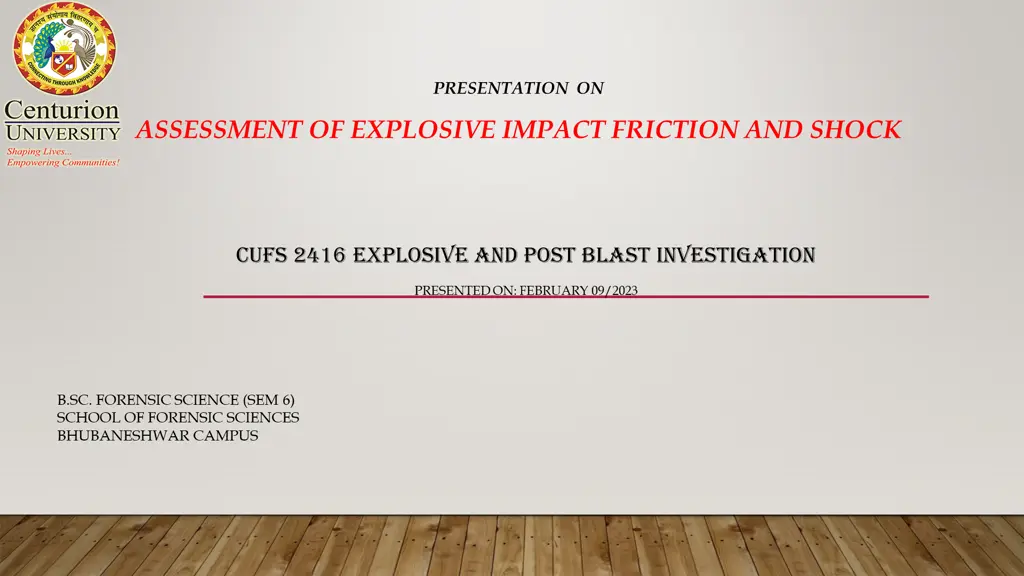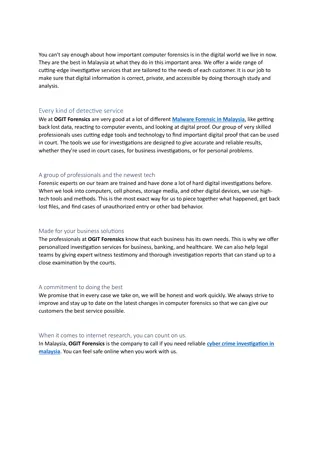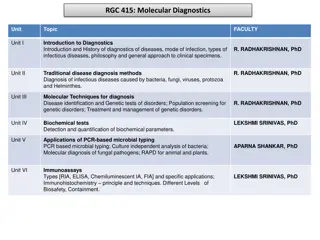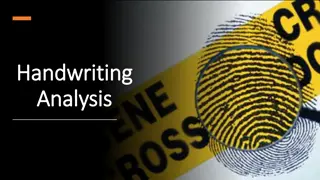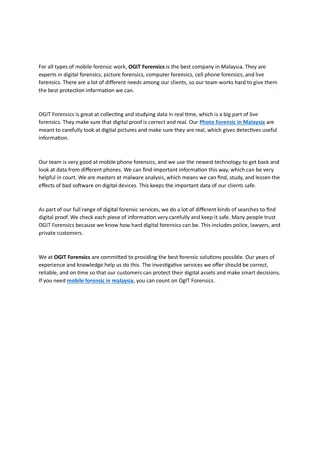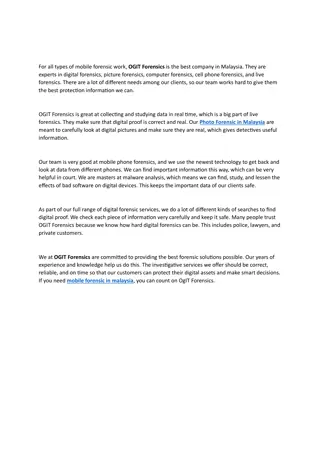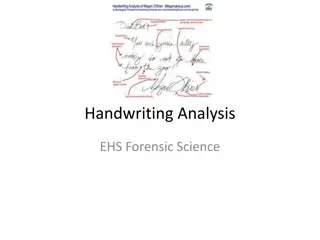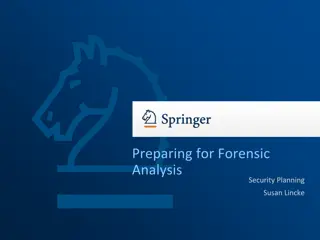Analysis of Explosive Impact in Forensic Science
Explore the assessment of explosive impact, friction, and shock cufs in forensic science. Delve into post-blast investigations and their significance. Presentation on Feb 09, 2023, at School of Forensic Sciences, Bhubaneshwar Campus.
Download Presentation

Please find below an Image/Link to download the presentation.
The content on the website is provided AS IS for your information and personal use only. It may not be sold, licensed, or shared on other websites without obtaining consent from the author.If you encounter any issues during the download, it is possible that the publisher has removed the file from their server.
You are allowed to download the files provided on this website for personal or commercial use, subject to the condition that they are used lawfully. All files are the property of their respective owners.
The content on the website is provided AS IS for your information and personal use only. It may not be sold, licensed, or shared on other websites without obtaining consent from the author.
E N D
Presentation Transcript
PRESENTATION ON ASSESSMENT OF EXPLOSIVE IMPACT FRICTION AND SHOCK CUFS 2416 EXPLOSIVE AND POST BLAST INVESTIGATION PRESENTED ON: FEBRUARY 09/2023 B.SC. FORENSIC SCIENCE (SEM 6) SCHOOL OF FORENSIC SCIENCES BHUBANESHWAR CAMPUS
CONTENT Sensitivity test Sensitiveness to impact (What is an impact sensitive explosive ) Sensitiveness to friction (Friction Hazards and Can friction cause explosions?) Sensitiveness to shock (Shock (Impact) and, What is explosive shock sensitivity?) Sensitiveness to Ignition Explosive Power Stability Test
INTRODUCTION Explosives are chemical compounds substances or mixtures of substances that have a large amount of energy and which, under the influence of external action, break down suddenly, violently with heat release and gas formation capable of generating mechanical work. Throughout the course of the explosives, having as their starting point manufacturing and end-use by the operator (authorized craftsman), these products may be / are subjected to various demands (friction or impact) that may endanger the life and health of persons and can destroy material goods, affect the environment etc. Prior to use (making available on the market), explosives are subject to different laboratory tests to ensure compliance with the essential safety requirements applicable to each type and to match the ballistic / physic-chemical / thermodynamic parameters within speci-fied manufacturer specific explosive ranges
WHAT IS ASSESSMENT OF EXPLOSIVE ? The assessment of explosives involves evaluating their properties and characteristics to determine suitability for specific applications, and their potential hazards in manufacture, handling, transport and storage requirements, as well as its compatibility with other materials considering factors such as reaction rate, heat release, pressure generation, and potential for harmful by-products.The goal is to determine safe use and minimize risk.
SENSITIVENESS TEST Sensitiveness tests of explosives are used to evaluate the degree to which an explosive material is responsive to stimuli(mechanical or thermal) such as impact, friction, heat, or electrical sparks. The results of these tests help to determine the stability and safety of an explosive, and are used to classify the material into different hazard categories.
TYPES OF SENSITIVENESS TEST Some common sensitiveness tests include: Impact tests, which measure the explosive's responsiveness to a sudden physical shock, such as striking or dropping. Friction tests, which evaluate the explosive's sensitivity to friction-generated heat or sparks. Electrostatic discharge tests, which measure the explosive's response to electrical discharge. Thermal tests, which evaluate the explosive's sensitivity to heat, such as exposure to fire or high temperatures.
SENSITIVENESS TO IMPACT The test for determination of the impact sensitivity of explosives method consists in the fall of a specified mass hammer, from a fixed height, on the explosive sample tested and the calculation of the minimum impact energy at which at least one reaction is obtained, out of six tests . BAM Fall Hammer BFH-12A is equipped with the automated lifting mechanism which allows to remotely operate the positioning, dropping and collection of a drop weight via a touch screen of a remote control unit.The equipment is fitted with a drop-down weight change window for a quick, easy and safe weight change. Fig BFH 12 Machine
WHAT IS AN IMPACT SENSITIVE EXPLOSIVE Impact sensitivity is the property of explosives to detonate by impact and is a parameter that characterizes the safety of explosives in handling and transport. It is expressed in Joules (J), representing practically the minimum impact energy at which the explosion of the explosive sample occurs.
SENSITIVENESS TO FRICTION Sensitiveness to friction assessed by subjecting small samples of the explosive, placed on anvils of Anvil of hardwood hardwood, softwood and Yorkstone, to glancing blows from a boxwood mallet. In general, materials having a low F of I are comparatively sensitive to friction and materials having a high F of I comparatively insensitive. Yorkstone
CONTINUE.. Materials having an F of I below 20 or a positive response in friction tests on softwood are classed as very sensitive, those having an F of 1 20-90 or undergoing ignition on Yorkstone are sensitive And those having an F of I above 90 and failing to ignite on Yorkstone are classed as comparatively insensitive . The friction sensitiveness of this last category may be assessed by using a mild steel mallet and anvils of mild steel, naval brass and aluminium bronze.
FRICTION HAZARDS Currently, there is no correlation to predict friction sensitivity. If a material has highly energetic functional the oups, displays unexplainable discoloration when subjected to handling, displays characteristics of being shock sensitive, or is highly exothermic, it is prudent to conduct a friction hazard evaluation. Friction Tes-The most common test method used to identify and measure the sensitivity of a substance to frictional stimuli is the Bam Friction Test .
CAN FRICTION CAUSE EXPLOSIONS? Mechanical friction is still the main causes of explosive gas ignition in the industry to day, and this trend appears to be stable (Marmo et al., 2015). Frictional processes caused by malfunctions may lead to hot surfaces and mechanical sparks.
SENSITIVENESS TO SHOCK Sensitiveness to shock of cast and pressed explosives is often compared by determining the maximum thickness of the brass shim or card gap which can be interposed-between the test sample (the receptor) and a standard detonating charge (the donor) without preventing detonation of the receptor. In this test, a shock wave generated by an explosive donor charge is delivered to the test sample (acceptor charge) through an inert shock and the relative sensitivity of the acceptor charge is expressed in terms of the attenuator length for which detonation occurs in 50% of the trials.
SHOCK (IMPACT) AND EXPLOSION HAZARD IDENTIFICATION As a first step, a literature search and review of the material safety data sheet (MSDS/SDS) should be conducted for indications of explosive properties. Many materials with these adverse properties can be identified because they have highly energetic functional groups, i.e., Nitro (R/Ar- NO2), N-Oxides (R3N+-O-), metal azide M(N3), etc. A full listing of explosive groups can be found in various references (Bretherick s Handbook of Reactive Chemical Hazards, Sax and Lewis, etc.). A useful screening test to estimate if a ma- terial has the potential to be shock and/ or funk sensitive. Shock test the most common test method used to identify and management the sensitivity of substance to shock is Bam fall hammer test.
WHAT IS EXPLOSIVE SHOCK SENSITIVITY? Shock sensitivity is a comparative measure of the sensitivity to sudden compression (by impact or blast) of an explosive chemical compound. Determination of the shock sensitivity of a material intended for practical use is one important aspect of safety testing of explosives.
ASSESSMENT OF EXPLOSIVE -IGNITION Assessment of explosive ignition is fore types:- a. Temperature of ignition b. Ease of ignition d. c. Ignition using electricity Types of ignition
TEMPERATURE OF IGNITION: The ignition temperature of a substance, in a solid, liquid, or gaseous state, is the minimum temperature required to start or cause combustion, regardless of an igniting element. For example; the ignition temperature of the fuel (petrol). Test: Temperature of ignition (Tof I) is determined on a small quantity of explosive, contained in a glass tube 10cm. long, heated at the rate of 5 c/min. materials giving results in the 140 c to 170 c range are found, in general, to have limited thermal stability.
EASE OF IGNITION The time-to-ignition (tig) characterizes the ease of ignition of the material by defining how quickly the flaming combustion occurs when the material is exposed to a heat source at a given incident heat flux and in an oxygen- controlled environment. In case of wood :Wood placed in an oven at 700 F. catches fire almost immediately. Test: The Bickford fuze test is used to assess the ease of ignition of a sample of explosive, contained in a test-tube 10 cm long, by a burst of flame, and to ascertain whether burning or explosion occurs.
TYPES OF IGNITION : There are 4 main categories of ignition sources: thermal, electrical, mechanical and chemical. There are many possible sources of ignition and those that are most likely will depend on the release scenario. Sources of ignition include electrical sparks, static electricity, naked flames, hot surfaces, impact,friction,etc. Test: In the so-called train test, a flame is applied for 1 minute to an unconfined 'train' of material and its ignition behaviour is observed.
IGNITION USING ELECTRICITY: An electronic ignition system is a type of ignition system that works electronic circuits, usually by transistors. The transistors are controlled by sensors to generate electric pulses which then generate a high voltage spark that can burn the lean mixture and provide a better economy and lower emission. Test: The electric spark test assesses the ignitability by electrostatic sparks.
EXPLOSIVE POWER Explosive power refers to the destructive energy released by an explosive material upon detonation. It is typically measured by the amount of pressure, heat, and damage generated by the explosion. It is the total work done by a standard quantity of explosive. ????????? ????? = ? ? It is used to determine the potential of an explosive to cause harm or damage. Explosive power is an important factor in evaluating the suitability of an explosive for specific applications, as well as its handling, storage, and transport requirements.
DETERMINATION OF EXPLOSIVE POWER The most commonly used method - Calorimetry Other methods o measuring the pressure generated by the explosion BALLISIC MORTAR TEST FIG. TRAUZL LEAD BLOCK TEST o measuring the amount of damage caused by the explosion TRAUZL LEAD BLOCK TEST FIG. BALLISTIC MORTAR TEST
STABILITY TEST The purpose of stability testing is to ensure that the explosive material will perform as expected when subjected to various environmental and operational conditions. The results of stability testing are used to evaluate the safety of the explosive and its suitability for specific applications. Types of Tests o Abel s heat Test o Vacuum Stability Test o Silvered Vessel Test
